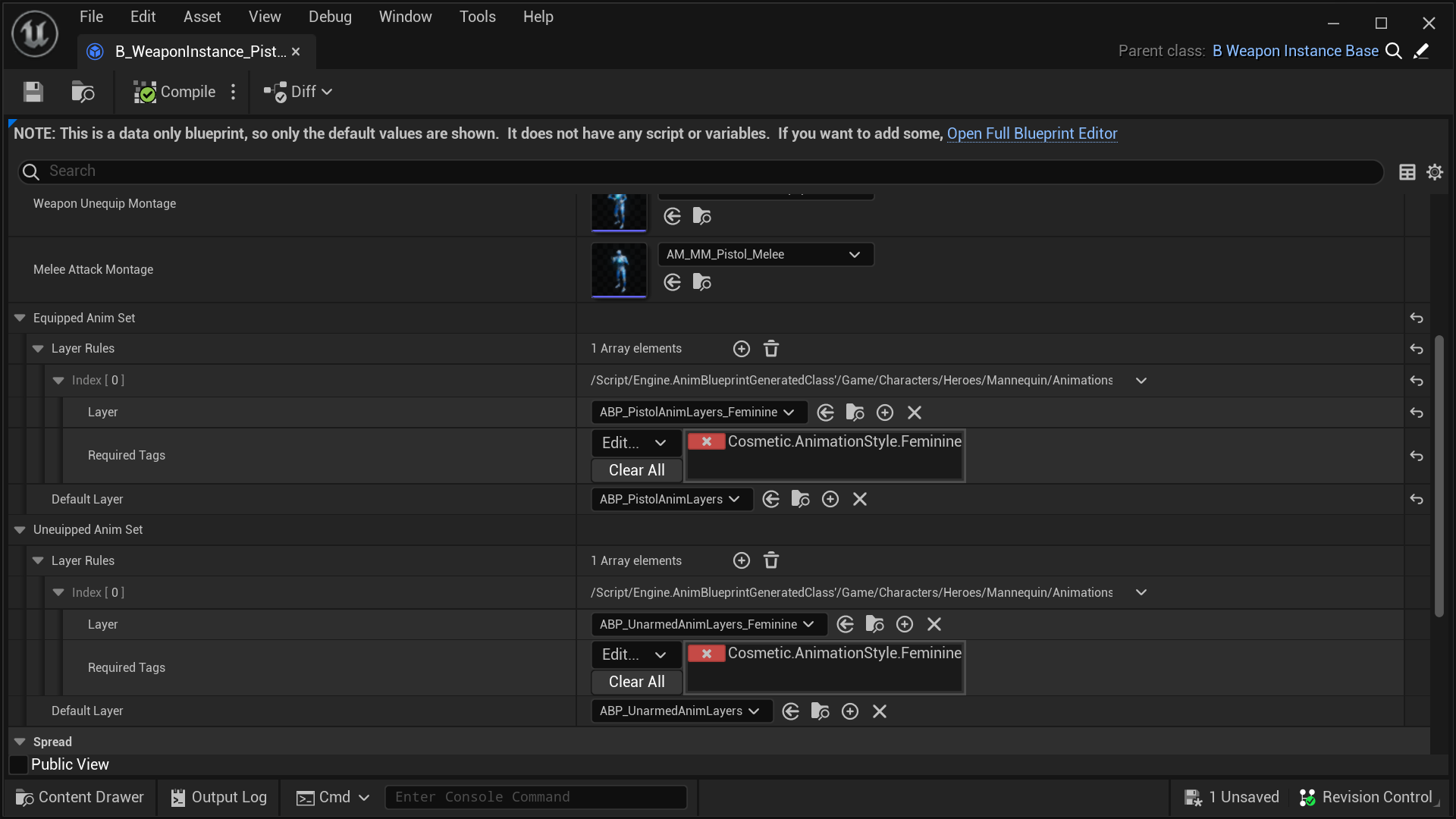Lyra Character Part
C++ Struct: FLyraCharacterPart
( Lyra 5.2
LyraCharacterPartTypes.h
)
This is one part of the Lyra Character Parts system, see that page for an overview.
Conceptual Overview
A “Character Part” is an actor that is attached to a Pawn, which represents a cosmetic part of the Character’s body.
The actual character body is invisible, and the cosmetic parts are what you see.
The character must have one or more parts to be visible. In vanilla Lyra, there are only
2 parts defined: B_Manny for the masculine mannequin
or B_Quinn for the feminine mannequin.
You may also opt to use modular characters, where a character is comprised of many different parts.
Lyra drives animation based on the Gameplay Tags defined by all of the Character Parts, for example to choose between masculine and feminine animation styles.
Properties of a Lyra Character Part
- Actor Class Type
- Socket Name to attach to (optional)
- Collision Mode (optional)
The Actor Class can optionally implement the IGameplayTagAssetInterface interface,
which allows it to communicate Gameplay Tags to the game.
Lyra uses the ALyraTaggedActor C++ class as the base for its cosmetic parts
to set Masculine or Feminine animation style tags,
and a Medium body style, for example. You can inherit from ALyraTaggedActor,
or implement IGameplayTagAssetInterface, or neither, as you prefer for your game.
Character Parts are considered to be equivalent if they are the same class type and attach to the same socket. Any difference in the collision setting is ignored for equivalence testing purposes.
Vanilla Lyra Character Parts
By default, Lyra defines only two Character Parts, representing either a male (Manny) or female (Quinn) body.
Character Part: B_Manny
The B_Manny blueprint defines the Manny body, the masculine mannequin.
| Property | Value |
|---|---|
| Base Class | ALyraTaggedActor |
| Gameplay Tags | Cosmetic.AnimationStyle.Masculine, Cosmetic.BodyStyle.Medium |
| Skeletal Mesh | SKM_Manny |
Character Part: B_Quinn
The B_Quinn blueprint defines the Quinn body, the feminine mannequin.
| Property | Value |
|---|---|
| Base Class | ALyraTaggedActor |
| Gameplay Tags | Cosmetic.AnimationStyle.Feminine, Cosmetic.BodyStyle.Medium |
| Skeletal Mesh | SKM_Quinn |
Driving Animation via Gameplay Tags
Lyra uses the Cosmetic.AnimationStyle.* Gameplay Tags to drive its animation,
so that it can animate Manny with “masculine” animations
and Quinn with “feminine” animations.
How exactly these animations work is beyond the scope of this documentation, however in general if you are interested in this, here are some things for you to search for.
In your C++ IDE:
FLyraAnimBodyStyleSelectionSet- In particular, this method:
SelectBestLayer- This is used by the
B_WeaponInstance_BaseBlueprint to select the animation set when ranged weapons are equipped or unequipped
- This is used by the
- In particular, this method:
ULyraWeaponInstance- In particular, this method:
PickBestAnimLayer
- In particular, this method:
In Unreal Editor:
B_WeaponInstance_Base- This is the base class for all ranged Lyra Weapons
- When the weapon is equipped or unequipped, it changes the animation style accordingly, based on the collective Gameplay Tags defined by all the Character Parts
- Search Gameplay Tag Asset References:
Cosmetic.AnimationStyle.Feminine- This will show you all of the Lyra Blueprints that reference this tag, including:
B_MannequinPawnCosmetics,B_Quinn,B_WeaponInstance_Base, etc.
- This will show you all of the Lyra Blueprints that reference this tag, including:
Example Pistol Animation Rules
As an example, when a Lyra Character equips or unequips a Pistol, the B_WeaponInstance_Pistol blueprint
defines the animation rules.
Above you can see that if any of the Character Parts defines the Cosmetic.AnimationStyle.Feminine
Gameplay Tag, the Character will use the ABP_PistolAnimLayers_Feminine animation blueprint
when the pistol is equipped.
Otherwise, the default ABP_PistolAnimLayers blueprint is used (the masculine version).
When the pistol is unequipped, then again if any of the Character Parts defines the Cosmetic.AnimationStyle.Feminine
Gameplay Tag, the feminine unarmed animation will be used (ABP_UnarmedAnimLayers_Feminine),
and otherwise the default masculine ABP_UnarmedAnimLayers will be used.
Note: this is not at all efficient; every single weapon is forced to define the same exact unarmed animation set rules, but that is how Lyra works by default.
Lyra Weapons are discussed in more detail.
Conflicting Gameplay Tags are not handled by default
By default, Lyra does not handle conflicting Gameplay Tags well.
If you assign one part that defines Masculine animation and another part that defines Feminine animation,
Lyra will not notice, and it will just select one of them.
It looks like it probably selects whichever animation set is defined first
in the FLyraAnimBodyStyleSelectionSet’s LayerRules, so in the above example,
the feminine animation set would always be used if both masculine and feminine tags are defined
by different Character Parts.
